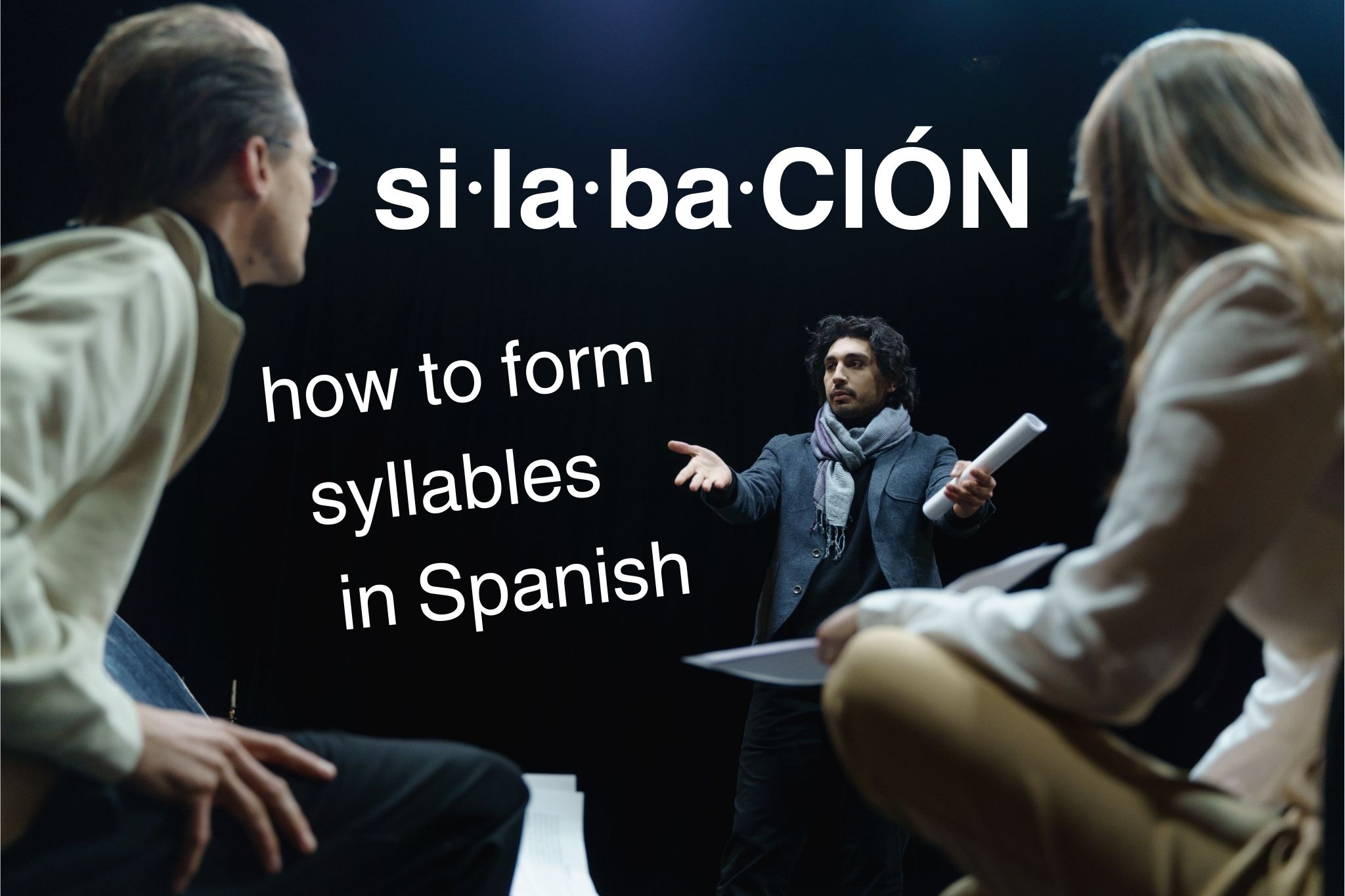Syllables in Spanish: A detailed guide to Spanish syllabification rules

Get our free email course, Shortcut to Conversational.
Have conversations faster, understand people when they speak fast, and other tested tips to learn faster.
More infoHave you ever wondered how Spanish words are broken down into syllables? If you’d like to uncover the secret code for pronouncing words correctly and understanding how words are put together, learning all about syllables in Spanish will do the trick.
In this guide we will walk you through the world of Spanish syllables, starting from the basics and moving on to the Spanish syllabification rules that help us split words into syllables. By the end, you’ll have a clearer picture of how Spanish words are crafted and spoken.
Let’s dive in and discover the magic of syllables in Spanish!
The basics: What is a syllable?
A syllable is a single, uninterrupted sound that typically consists of a vowel sound (also known as the nucleus) and which may be accompanied by one or more consonant sounds that come before (onset) and/or after (coda) the vowel. Syllables are the basic unit of speech, and they help us organize and understand the rhythmic and structural patterns of spoken language.
In simpler terms, when you pronounce a word, you can often hear the individual beats or units that make up the word. Each of these beats is a syllable. For example, the Spanish word “gato” (meaning “cat”) has two syllables, with two different sounds that make up the word: /ga/ and /to/.
In addition to pronunciation, breaking down a word into syllables can help us when writing. Just like in English, we can split a Spanish word up between its syllables when it needs to be written between two lines. This break is indicated with a hyphen attached to the end of the first half of the split word. As we see in our post on Spanish punctuation, the hyphen is known as un guión.
Word and syllable classification
Both words and syllables in Spanish are classified according to varying criteria. We will mainly focus on syllable classification here. However, since words are made of syllables, they also influence the composition of words, so we will include their classification, according to their number of syllables, and their stress.
Number of syllables
Words in Spanish can be classified according to the number of syllables in the word.
Words with just one syllable are monosílabas (monosyllabic words).
- té (tea)
- paz (peace)
- sal (salt)
When words have two syllables in Spanish, they are bisílabas (two-syllable words).
- perro (dog)
- ajo (garlic)
- papá (dad)
Words that can be divided into three syllables are trisílabas (trisyllabic words).
- caminar (to walk)
- chaqueta (jacket)
- tocino (bacon)
Finally, when Spanish words have four syllables or more, they are called polisílabas (polysyllabic words).
- murciélago (bat)
- estipulado (stipulated)
- otorrinolaringólogo (otorhinolaryngologist)
Stress
Syllables and words are both classified according to syllable stress.
In Spanish, syllables can be tonic or non-tonic. Tonic syllables are the ones stressed when pronouncing a word, while non-tonic syllables have more of a neutral intonation. For example, in the Spanish word “casa” (meaning “house”), the first syllable is tonic and the other one is non tonic: CA-sa.
From here, the placement of the tonic syllable in the word defines how Spanish words are classified according to stress, counting from the word’s final syllable. Words are classified as agudas if the tonic syllable is the last one, graves if the stress is on the second-to-last syllable, esdrújulas if the stress is on the third to last syllable, and sobresdrújulas if the stressed syllable is in a place in the word before the third-to-last syllable.
For the rest of this post, we’ll put the tonic syllables in all caps to point out where we stress the pronunciation in each of the Spanish words we use as examples, and we’ll separate the syllables with hyphens. Let’s start with these where we see which ones are agudas, graves, esdrújulas, and sobreesdrújulas:
- limón (lemon): li-MÓN – aguda
- pastel (cake): pas-TEL – aguda
- radio (radio): RA-dio – grave
- abrazo (hug): a-BRA-zo – grave
- crepúsculo (twilight): cre-PÚS-cu-lo – esdrújula
- bolígrafo (pen): bo-LÍ-gra-fo – esdrújula
- románticamente (romantically): ro-MÁN-ti-ca-men-te – sobresdrújula
- fácilmente (easily): FÁ-cil-men-te – sobresdrújula
As you may have noticed, syllable stress is directly correlated with the use of accent marks in Spanish. Not every word has an accent, however. If you want an in-depth explanation of accent rules, we recommend our post on Spanish accent marks.
Number of letters
Spanish syllables themselves can be classified as simple or complex, depending on the number of letters in each syllable.
Simple syllables are those that have only one or two letters, which are always either a vowel on its own, or a vowel and a consonant.
- ajo (garlic): A–jo
- mesa (table): ME–sa
- lobo (wolf): LO–bo
Complex syllables have more than two letters and present us with a set of sounds that are more difficult to pronounce. These syllables are usually composed of two consonants and a vowel. In addition, certain syllables can have multiple vowels, as we’ll see in the latter sections of this post.
- Bruselas (Brussels): Bru-SE-las
- cortada (cut): cor-TA-da
Type of opening
The final letter of a syllable also defines how it can be classified, based on whether it ends with a vowel or a consonant sound. Syllables ending in a vowel are known as abiertas (open), or they’re considered cerradas (closed) if they end in a consonant.
- ropa (clothes): RO–pa – both syllables are abiertas
- canción (song): can–CIÓN – both syllables are cerradas
Syllabification rules in Spanish: Breaking down Spanish syllables
Now that we know what syllables are and how to classify them, let’s talk about syllabification, also known as syllabication in English, and known as silabeo or silabación in Spanish. Syllabification is the process of dividing words into syllables according to the vowels and consonants in each word.
Before we cover each rule in detail, keep in mind the following fundamentals:
- Spanish syllables must contain at least one vowel, as they are the nucleus of the syllable.
- Vowels can form syllables by themselves.
- There can be multiple consonants in a single Spanish syllable.
Alright, now let’s take a look at the Spanish syllabification rules. We’ll start with the rules based on consonants.
Consonants at the beginning of the word
Any consonant, or sequence of consonants, at the beginning of a word forms a syllable with the following vowel.
- lata (can): LA-ta
- cromo (chrome): CRO-mo
- brisa (breeze): BRI-sa
Consonants at the end of a word
Any consonant, or sequence of consonants, at the end of a word is grouped with the preceding vowel.
- récords (records): RÉ-cords
- estación (season): es-ta-CIÓN
- español (Spanish): es-pa-ÑOL
A consonant between two vowels
When a consonant falls between vowels, it forms a syllable with the vowel that follows it.
- azul (blue): a-ZUL
- formalidad (formality): for-ma-li-DAD
- loro (parrot): LO-ro
Two consonants placed between two vowels
If there are two consonants located between vowels, syllabification occurs based on whether the consonant clusters are separable or inseparable. The following consonant pairs are inseparable, so they form a syllable with the following vowel: ch, ll, rr, bl, br, cl, cr, dr, fl, fr, gl, gr, pl, pr, and tr.
- leche (milk): LE-che
- caballo (horse): ca-BA-llo
- carro (car): CA-rro
- apretado (tight): a-pre-TA-do
- abrigo (coat): a-BRI-go
- madrina (godmother): ma-DRI-na
- ocre (ochre): O-cre
- agricultura (agriculture): a-gri-cul-TU-ra
- azufre (sulfur): a-ZU-fre
- nublado (cloudy): nu-BLA-do
- chicle (chewing gum): CHI-cle
- regla (rule): RE-gla
- aflojar (to loosen up): a-flo-JAR
The two-consonant sequence tl is divided into syllables in Spanish in two different ways, depending on the region. It is usually considered inseparable in Latin American Spanish, so the tl is connected to the syllable of the following vowel. In most of Spain, however, the t and l will separate into different syllables. There’s even some variation within regions though, so both versions are essentially correct:
- atleta (athlete): a-TLE-ta – common in Latin America
- atleta (athlete): at-LE-ta – common in Spain
Any other two-consonant sequences are always broken apart into distinct syllables:
- pacto (pact): PAC–to
- cambio (change): cam–bio
- almendra (almond): al–MEN-dra
- agricultura (agriculture): a-gri-cul–TU-ra
Three consonants placed between two vowels
If there are three consonants in a row between two vowels, the first two are usually joined to the preceding vowel, while the third forms part of the following syllable.
- constancia (perseverance): cons–TAN-cia
- perspectiva (perspective): pers–pec-TI-va
- istmo (isthmus): IST–mo
However, for consonant clusters whose last two letters are a combination of b, d, f, g, p, or t, or followed by l or r, then these pairs stick together with the following vowel and only the first consonant goes with the preceding vowel. These are the inseparable pairs in this case: bl, br, dl, dr, fl, fr, gl, gr, pl, pr, tl, and tr.
- comprar (to buy): com–PRAR
- costra (scab): COS–tra
- ancla (anchor): AN–cla
- estrella (star): es–TRE-lla
Four consonants placed between two vowels
When there are four consonants between two vowels, the first two go with the preceding vowel and the other two are part of the following syllable.
- monstruo (monster): MONS–truo
- abstracto (abstract): abs–TRAC-to
- construir (to build): cons–TRUIR
Adjacent vowels: Hiatus, Diphthongs, Triphthongs
Where two vowels are adjecent to each other with no consonant between them, they may be separated into two syllables (hiatus), or they’re pronounced together as a single syllable (dipthongs and triphthongs). This all depends on the vowel type, and whether the vowel is accented.
Spanish vowels are categorized either as strong or weak vowels, also known as open or closed vowels. The strong / open vowels are A, E, and O, while the weak / closed vowels are I and U. Note that when pronounced with an I sound, the letter Y also acts as a weak vowel.
These vowel types are fundamental to the syllabification rules we’ll see here for hiatuses, diphthongs, and triphthongs in Spanish.
Hiatus syllabification rules
Before we go into the rules for diphthongs and tripthongs, where adjacent vowels form a single syllable, let’s look at the the rules for hiatuses. A hiatus is the separation of two vowel sounds into distinct syllables.
Two strong vowels together (A, E, O)
Adjacent strong vowels are always in separate syllables.
- koala (koala): ko–A-la
- cacao (cocoa): ca-CA–o
- teatro (theater): te–A-tro
- traer (to bring): tra–ER
A strong vowel (A, E, O) with an accented weak vowel (Í, Ú)
This combination is similar to the previous one, since the accent adds a stress on the weak vowel. In these cases, the two adjacent strong-acting vowels are in separate syllables.
- río (river): RÍ–o
- oído (ear): o–Í-do
- país (country): pa–ÍS
- cirugía (surgery): ci-ru-GÍ–a
Two identical weak vowels (II or UU)
This is an uncommon order for letters, but when it occurs, the two weak vowels each fall in separate syllables.
- antiinflamatorio (anti-inflammatory): an-ti–in-fla-ma-TO-rio
- duunviro (a Roman-era magistrate): du–un-VI-ro
Diphthong syllabification rules
A diphthong is the combination of two vowel sounds within the same syllable. In a diphthong, the two vowel sounds are pronounced together in a way that creates a single, gliding sound. One of the vowel sounds in a diphthong is typically stronger or more prominent, while the other is weaker and less distinct.
In this section we’ll learn the different ways diphthongs occur in Spanish. The general rule is that unaccented weak vowels won’t form their own syllables.
Strong vowel (A, E, O) with a weak vowel (I, U)
A strong vowel with a weak vowel creates a diphthong, as long as the weak vowel has no accent.
- aire (air): AI-re
- pienso (I think): PIEN-so
- biología (biology): bio-lo-GÍ-a
Two different weak vowels (I, U)
Two adjacent weak vowels always form a diphthong, as long as they’re not the same and neither one has an accent.
- ciudad (city): ciu-DAD
- buitre (vulture): BUI-tre
- muy (very): muy
The special case with Ü
Let’s talk about a unique case that deserves a specific explanation when breaking words into syllables in Spanish: the presence of the ü.
This phenomenon specifically impacts the phonetic segments gue and gui, since these are the only letter combinations where the Spanish ü is found. Rather than indicating stress or intonation, the appearance of the u with an umlaut above it means that the ü is pronounced distinctly.
Without the ü these segments are pronounced very quickly, with almost no sign of the u, enunciated as /ge/ and /gi/ with a soft g sound. With the umlaut, on the other hand, güe and güi require clear pronunciation of both vowels in the diphthong, enunciated as /gue/ and /gui/.
So, a word like “aguijón” (sting) is pronounced as /a.gi.’hon/, while “pingüino” (penguin) is vocalized as /pin.’gui.no/.
Regarding syllabification, since the segments gui and gue form a single phonetic segment, they are always part of the same syllable. When the umlaut is present, it forms a diphthong like the others we looked at in the previous sections, so güe and güi remain in a single syllable as well.
The pronunciation of the segments in these examples therefore differs between the u and ü spellings, but the syllabification remains the same.
- Albergue (shelter): al-BER-gue
- Cigüeña (stork): ci-GÜE-ña
- Guiño (wink): GUI-ño
- Güiro (a Latin American musical instrument): GÜI-ro
Triphthong syllabification rules
A triphthong is a sequence of three vowel sounds in the same syllable. In Spanish, they always consist of one strong vowel surrounded on either side by unstressed weak vowels.
- Uruguay: U-ru-GUAY
- miau (meow): MIAU
- buey (ox): BUEY
Conclusion: Spanish syllable rules
This has been a pretty detailed post, explaining all of the rules on how to break down words into syllables in Spanish.
First we covered the basics, explaining what syllables are, along with how we classify Spanish syllables by name. Then we jumped right into our Spanish syllabification rules, known as silabación or silabeo in Spanish.
We covered all the possible rules, explaining and demonstrating how syllable division is affected according to the combination of vowels and consonants within a word. Regarding vowel combinations, we covered the rules for diphthongs, triphthongs, and hiatuses. In all, these Spanish syllabification rules affect proper pronunciation, in addition to writing.
We know that these rules can be a lot to remember, but don’t worry, the more you practice, the easier it gets. If you’ll need to review your Spanish syllabification rules in the future, you can bookmark this post so you’ll always have this detailed guide whenever you need!



